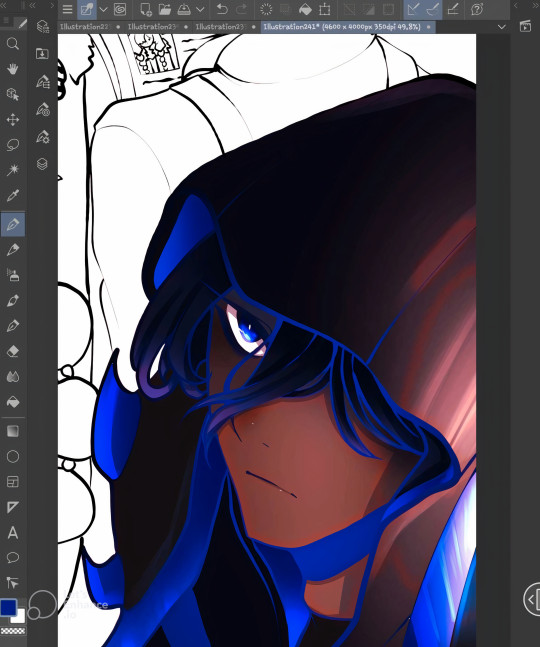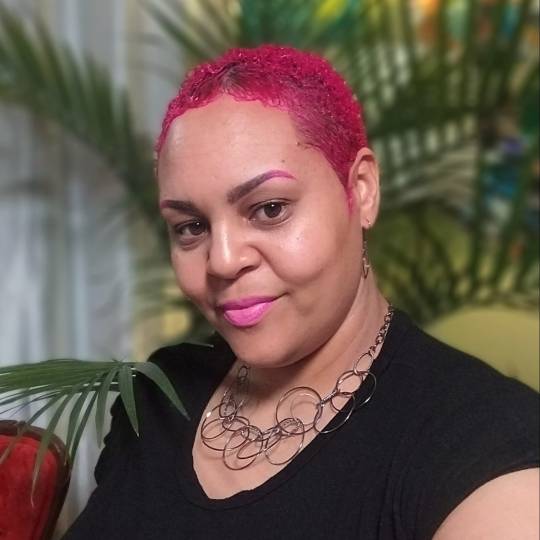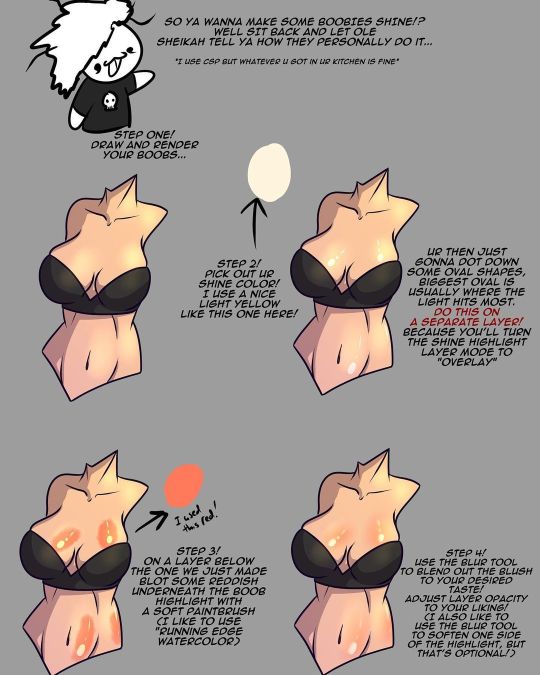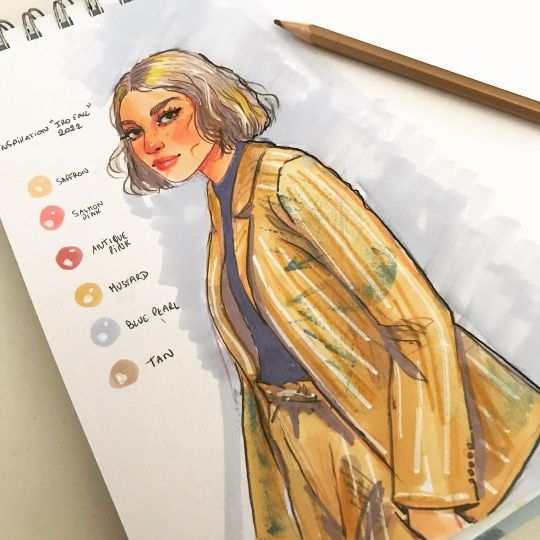#arttips
Text
Getting followers on Tumblr can be complicated
I have 7800 followers and the most engagement I have received is when I:
1: Make a piece of fan art for a popular game or series
2: Make an engaging drawing or a challenge that people feel intrigued to interact with.
3: Get reblogged from a popular artist with a following
I highly recommend you include as many tags as possible and interact with blogs that reblog content. If somebody gives your art a like it will not show up to there followers. what you need is reblogs to reach more people.
At the same time if you yourself run an art blog where you reblog a lot of other peoples art it will be harder for your followers to find your art when they click on your blog. Use a unique tag #(insert name here)art for your art or run 2 tumblr blogs (You can make multiple)
In the end Having more followers does not mean that they will always interact with all your content. For example despite me having 7800 majority of my followers are most likely not using tumblr anymore and the people still here may only want to reblog things that appeal to them. Some follow me for pokemon art. some follow me for furry art. While tumblr was most active I did not receive a lot of commission inquires. Deviantart was still more reliable to reach clients even though I have less followers there.
Feel free to reply with your own experiences as an artist on tumblr.
33 notes
·
View notes
Text
Hey Guys I have started making a simple beginners tutorial 'course' of videos as some of you had asked for some structure to follow along with! ❤️
Free Drawing Course!
#howtodraw#anime#manga#cosplay#howtodrawanime#drawing#drawingtutorial#art#arttips#beginnerartist#mikeymegamega#mangadrawing#body#bikini#bikinimodel#cosplaygirl#proportions#drawingprocess#timelapse#timelapseart#timelapseartwork#character#characterdesign#artist#artcourse#artfyp#arttrend#educateyourself#educational#howto
6 notes
·
View notes
Text
are you really fighting me over buttered artichokes?? who are you? Caravaggio...?
3 notes
·
View notes
Text
Tips and Tricks For Beginner Artists
I want to preface this by saying two things. Or maybe couple more.
One: This is my first ever blog post that I have written. There will be mistakes. I am still figuring out Tumblr Blogs. Deal with me. Thank you <3
Two: I am by no means a professional artist. I am still a student. I have been doing art for little over three years now and I am writing these to share my experiences as an artist that is self-taught. Also because I struggle with the mental aspect of art. I want to share and help people that are where I once was. I wish I had found somebody to give more personal, down to the bits advice to get me into the world of digital art. I am writing about what worked for me and how I did certain things. Enjoy.
(I am largely a digital artist. This is centered around digital mediums and methods. )
This blog post will be more helpful for people that are self-teaching and just starting art.
Regardless of why you want to do art, you need adequate tools to do it.
My first and current graphic tablet is One By Wacom in Small (ought to be replaced soon). I still use it and it serves just fine. It has no buttons on it, plain design. Wacom has excellent support and works smoothly. It was also a good budget decision. If you have a tablet that comes with a pen, work on that. Keep in mind, if you are intently buying a graphic pad or a tablet for purpose of art, buy something that you won't regret too much if art doesn't work out for you and it ends up collecting dust. It is easy to upgrade once your needs require it. Research what graphic tablets are out there and what would work best for you. There is a wild variety to choose from.
Now to the art program. Finding an art program to start on is not at all hard now. There are so many, each with its own quirk. I used Krita since forever. It is very professional, much like Photoshop but also easy for a beginner to grasp. And entirely free. Find an art program that you are comfortable in. Procreate, MediBang, Clip Studio Paint, Paint Tool SAI, Photoshop are only some of the choices.
Possibly in another post I will get more into Krita and how I use it as I am very fond of it.
Set Up Your Canvas
Here I am not going to go way too much into depth on this as it can vary greatly depending on what tools you use and what program but I want to stress the importance of having a workspace that works with you, not against you. Some of the best tips I have gotten for this are:
Set your canvas to a a medium gray color, somewhere in the middle of the gray value scale. Looking at a plain white canvas is daunting and quite inconvenient when you're starting off.
Pick your resolution. Usual choice is 300 dot per inch (DPI). Size of your canvas depends on your screen/machine/program. I usually go between 2000-2500 as my PC is past its prime and doesn't handle things well without sounding like a rocket about to take off. Research what your machine can do without lag.
I will give more advice on using brushes in another post but just going to say, using plain black color is usually bad idea. At least it was for me. It amplifies mistakes and leaves little room for fixing. Instead, try using a gray color somewhere between black and your canvas color. Medium value blue and red also work fine as sketch colors.
Start Comfortably
There is no point looking at all the masterpieces that ArtStation and Instagram has to offer and setting it as your short-term goal. A biggest downfall you can have is from starting too big.
Instead, focus of doing small things. Sketch a lot. Sketch basic shapes. And draw what you love. Art is a craft of heart, at least for me. Detaching yourself from that will make art will like a chore, a cold labor that you do not enjoy.
Ahem. Anyway.
One of the best exercises I have found is to just draw lines. This you can do on paper too as it is an excellent way to warm up. Try to make a straight line. Go not too fast nor slow. Make as many as you need until you get it straight. Do the same for circles. Make them as round as you can. Your hand is the biggest trickster. It does not cooperate with your mind as well as you want it to.
Sketch, sketch sketch, get yourself comfortable with it. Everyone does sketches, one way or another. Of course, you are free to try an entire piece but it can be very discouraging when it turns out nothing like you expected it to be.
I will make a post just on the ways you can practice as a beginner.
Find Inspiration
The biggest foe of artists is lack of inspiration and an artists block. I know it was mine. Finding inspiration is way easier when you are starting off as you often want to draw everything. There are plenty of places where you can get inspiration on what to draw. Pinterest in my all time favourite. You can also look at Instagram, ArtStation, your favourite shows, camera roll, world outside. Jot down what you want to draw when you get an idea and save it for later.
Find Artists You Love
This goes for everyone, but especially if you want to get into business of art. Having artists that inspire you and whose art you enjoy seeing is a must. It feeds your creativity and helps you develop your art style in the long run.
Don't compare yourself to other artists
Often, artists you see that get most views and likes have been in it for years. Do not go into art expecting that it will look perfect right away. Art takes time. A lot of it, often. Those artists whose works seem perfect have spent countless hours on sketches, studies, classes, lessons. Stressing over why your art is not good at the very start will not allow you to move on and better. Instead, appreciate and enjoy little what you created. Everyone's art journey is different and what matters is the road, not the destination
You don't have to be a natural
I never was exceptionally good at art growing up I did have an affinity for all things creative—I had passion for it, but my skills weren't out there. Majority of artists aren't naturals. In my opinion, passion and will is more important than natural skill set. Skills can be taught but without passion and will to learn, you won't get anywhere in art.
Your journey is unique
Everyone learns things at a different pace. What works for somebody, might not work for you. We all have different minds.. That is why everyone's art journey is so unique and interesting. When I started off, I was doing things exactly as I saw others do them and it resulted in frustrations because it wasn't turning out the way I imagined it would. Beginners are inclined towards this and that's alright. But it is important to realize that there is no law out there on how you have to learn the craft. Do it in a way that is most comfortable.
For example, I have quite an attention deficit. I cannot focus on a subject for longer than 15 minutes tops. So watching hour long lessons on Youtube or reading books on the subject didn't cut it for me. I either broke it up into smaller bits and only took what I needed in the moment or looked for compact, one-slide lessons, usually with examples, to tackle a subject. Rather than being told what to do, I needed to be shown how to do it. This might not be a good way for somebody, it really depends and comes down to you. You know yourself the best.
Now for the more practical tips
Outlining
This might be a controversial one out there, but I was never a strong believer in outlining. While it can be fun and it is helpful in beginning stages, it eventually stunts your growth. Instead of simply just outlining, look at how the things work and why does it look the way it does. Break down shapes and study them. Of course, there are instances where it does help to do it and I am not saying that you shouldn't do it, I just never did it. In my opinion, training your hand and mind to follow references is much better way to study and improve.
Use References
Do it. The best of artists use them or have used them for a large portion of their art journey. Do not see reference images as a cheat for artists. Drawing from mind is difficult and not something I would suggest to somebody starting off. Instead, find several references—for poses, shapes, color palette. The more references you have, more you will learn. I use Pinterest for this mostly. As I get can very easily distracted, I usually prepare them couple of hours in advance or a whole day before and store them so I can use them in the future whenever I need.
Don't just look at at the image and completely try to mirror it. Improvise. That's how you learn. Study it. Draw over the reference and then draw next to it. Do it as many times as you want and do it on several references. Sometimes it is enough to do reference thumbnails to effectively improve your art for the day.
Learn from Other Artists
I will make a special post on what artists I watched and learned from and how the self-teaching process looks for me. Regardless of how you study art (art school or not), it is important to find as many resources and sources as you can. Do not focus too much on narrowing it down to a specific thing. Look for lectures on basics that will prepare you for any course you might want to take, especially if you are self-taught.
Practice. Practice. Practice.
This advice I got from listening to my favourite art podcast from Adam Duff LUCIDPIXUL and it gives you this comparison.
If you spend a year reading fitness magazines but never go to the gym, are you going to get fit? No.
Try to make a routine and set the time when you are free to draw. More you do it, faster you will progress and develop your skill. No matter how bad it looks to you, just draw. You don't even have to complete it. Just sit down and put something on the canvas or paper. If it doesn't work, store it and move on. You learned something and will be better next time. It only looks bad if you didn't draw anything.
I hope this tips got to you and that you find them as helpful as I did. Happy drawing!
____________
I am a self-taught digital artist from Serbia. I hope to help people by sharing my art, process and advice that has and still is helping me.
#art#digitalart#artadvice#selftaughtartist#illustration#arthelp#arttips#tipsforbeginnerartists#artists on tumblr#artblog#artblr#digital artist#myartwork#artwork#drawing#digitaldrawing#digitalartprocess#artprocess#beginnertips#useful#reference#wacom#artcommunity#howtodraw#howtoart
3 notes
·
View notes
Text

My pixel art tips!
2 notes
·
View notes
Text

Trust the process 🐺 #wip
#dndart#dndcharacter#dnd#dndartist#dndcharacterart#dndartwork#oc#originalcharacter#ocart#ocdrawing#ocartwork#ocartchallenge#artprocess#arttips#digitalartwork#digitalartist#digitalillustration#digitalart#digitalpainting#webtoon#webcomic#webtooncanvas#artist on tumblr#my oc art#webtoon canvas#webtoon artist#illustration#digital illustration#digital aritst#tapas
2 notes
·
View notes
Text
How to Use Our Sketchbook to Improve Our Painting Skills
I mentioned how important it is to use a sketchbook in a previous post and gave tips to fill your sketchbook with inspiration.
ImImage by Cally Lawson from Pixabay
Here I would like to explore why keeping a sketchbook is such an excellent way to improve our painting skills and will give you a few tips to make it happen.
Practice: A sketchbook is a place to experiment with different materials,…

View On WordPress
#Art#arttips#creating#Creativity#Drawing#Painting#practice#sketchbook#Sketchbookchallenge#Sketchbookideas#Sketchbookinspiration#SuzanneBelair
2 notes
·
View notes
Text
God Please let this end.
How do I decorate a new sketchbook without it looking like A CHILDRENS SCRAPBOOK. helppp.
#sketchbook#sketch#art#arttips#art tips#help#art help#advice on art#sketchbook decorating#how do i decorate a sketchbook
2 notes
·
View notes
Text
What color is your favorite artist's hair? 😜

#artist#hairart#pink hair#follow#artlessons#artteacher#art#arttips#artists on tumblr#painting#paintingtips#arttherapy#art tutorial#arttutor#artclasses
3 notes
·
View notes
Text
My actual best tip for art block
Draw something you would have in middle/elementary school
Make it fucking suck
Draw a shitty sparkledog or an emo catgirl or some shit
We all have a cringe meter and if that meter gets full you just gotta draw something cringe before you get to the good shit
Also download a cute notes app on your phone and write down your ideas there because in my experience its easier to write shit down if theres an incentive (in this case cutesy pages) to do so
Make some shitty art
Love,
Your mentally ill big sister
#i’ve had art block for like 3 weeks#so i drew a fuckin furry emo catgirl with shitty chibi anatomy#art#digital art#arttips#literally nothing will inspire you more than your younger self#also redraw old art#kinda like… restarting the level#you gotta go back to get on track
4 notes
·
View notes
Text
Courses for Beginner Artists
Courses for Beginner Artists
When you first start out with art, be it drawing, acrylic, watercolor or other mediums, it is hard to learn these skills by yourself. I know, because that’s what I did. But I have become better at reaching out and finding tools that can better my skills faster and on the areas I need to improve. So in this post I’ll show you some tools that I would have used if I’m just starting out, dipping my…

View On WordPress
#artcourse#artcourses#arthelp#artist support#artisthelp#arttips#beginner#beginnerartist#blog#Courses#courses for beginner
2 notes
·
View notes
Photo

Friend of mine asked me to throw together a quick boob shine tutorial so here it is! It’s pretty hastily slapped together but this is basically how I get dat shine, lads. - - - #art #artist #tutorial #arttips #arttutorial #clipstudiopaint #csp https://www.instagram.com/p/CeFQhsjs0Aa/?igshid=NGJjMDIxMWI=
4 notes
·
View notes
Text
Painting TIPS: Hair 💇♀💡🖌 When painting hair, pay close attention to the flow and movement of the strands. 🎨💇🏾♂Hair rarely lies flat and often has a natural rhythm to it. Take a moment to study reference if you need to or visualize how the hair moves in different directions. This will add a realistic touch to your artwork and bring it to life! 💫
•
This is painting is part of my upcoming solo show “Nurtured by Nature” @coreyhelfordgallery in August!👀. Stay tuned for more updates. 🙌❤
8 notes
·
View notes
Text
hope this nice expensive mechanical pencil i bought on a whim somehow magically cures the creative block
3 notes
·
View notes
Photo

#fashiondrawing #fashion #fashionsketch #artmarkers #promarker #dailysketch #dailydrawing #quicksketch #drawingpractice #drawingoftheday #drawwithme #drawingportraits #drawingfaces #arttips #drawingtips (à France) https://www.instagram.com/p/CdLhpVQIj_K/?igshid=NGJjMDIxMWI=
#fashiondrawing#fashion#fashionsketch#artmarkers#promarker#dailysketch#dailydrawing#quicksketch#drawingpractice#drawingoftheday#drawwithme#drawingportraits#drawingfaces#arttips#drawingtips
6 notes
·
View notes
Text

more free resources and tips
on my patreon: https://www.patreon.com/user?u=120736104
done in "hlfaceposer"
inspired by Barry Langdon-Lassagne
#gmod#garrysmod#steam#gamingontikok#garry#gmodvideos#gamingontiktok#gaminglife#gamingcommunity#videogames#game#sfm#sourcefilmmaker#sfmtutorial#tutorial#halflife2#halflife#valve#alyxvance#facialexpression#face#arttips#arttutorial#arthacks#3d#3dmodeling#artistsoftiktok#sculpting#sculpture#sculptureart
0 notes